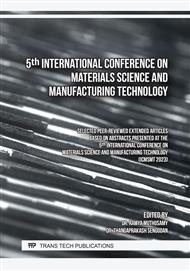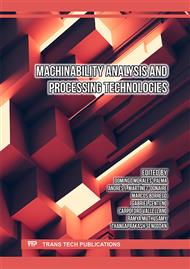[1]
KUKL, Annual Report (14th Anniversary), Kathmandu Upatyaka Khanepani Limited, Kathmandu, Nepal, 2022.
Google Scholar
[2]
R. Li, Y. Lai, C. Feng, R. Dev, Y. Wang, Y. Hao, Diarrhea in under five-year-old children in Nepal: A spatiotemporal analysis based on demographic and health survey data, Int. J. Environ. Res. Public Health 17(6) (2020) 2140
DOI: 10.3390/ijerph17062140
Google Scholar
[3]
I. Bertuccio, M.V. Biezma Moraleda, Risk assessment of corrosion in oil and gas pipelines using fuzzy logic, Corros. Eng. Sci. Technol. 47(7) (2012) 553-558
DOI: 10.1179/1743278212Y.0000000028
Google Scholar
[4]
K.P. Dahal, S.K. Regmi, J. Bhattarai, A novel approach for proximate analysis of soil corrosion condition in Imadol-Sanagaun and Kantipur Colony areas of Nepal, Solid State Phenom. 338 (2022) 17-27
DOI: 10.4028/p-u7uv9u
Google Scholar
[5]
M. Baker Jr., R.R. Fessler, Pipeline Corrosion, in: Final Report, Integrity Management Program Under Delivery Order DTRS56-02-D-70036, Biztek Consulting, Inc., USA, 2008, p.78.
Google Scholar
[6]
S. Khakzad, M. Yang, A. Lohi, N. Khakzad, Probabilistic failure assessment of oil pipelines due to internal corrosion, Process Saf. Prog. (2022) 1‐11
DOI: 10.1002/prs.12364
Google Scholar
[7]
K. Zakikhani, F. Nasiri, T. Zayed, A failure prediction model for corrosion in gas transmission pipelines, in: Proc. Inst. Mech. Eng., Part O: J. Risk Reliab. 235(3) (2020) 374-390
DOI: 10.1177/1748006X20976802
Google Scholar
[8]
K.P. Dahal, Investigation of Soil Corrosion to Buried-Metallic Materials of Kathmandu Valley, Nepal, Ph.D. Thesis submitted to Institute of Science and Technology, Tribhuvan University, Kathmandu, Nepal, 2022, p.135.
DOI: 10.52547/jad.2022.4.1.4
Google Scholar
[9]
P.P. Bhandari, K.P. Dahal, J. Bhattarai, (2013). The corrosivity of soil collected from Araniko Highway and Sanothimi areas of Bhaktapur, J. Inst. Sci. Technol. 18(1) (2013) 71-77.
Google Scholar
[10]
R. Singh, Pipeline Integrity Handbook: Risk Management and Evaluation, Elsevier Science, UK, 2017.
Google Scholar
[11]
Z. May, M.K. Alam, N.A. Nayan, Recent advances in nondestructive method and assessment of corrosion undercoating in carbon–steel pipelines, Sensors 22(17) (2022) 6654
DOI: 10.3390/s22176654
Google Scholar
[12]
K.P. Dahal, R.K. Karki, J. Bhattarai, Evaluation of corrosivity of soil collected from the central part of Kathmandu Metropolis (Nepal) to water supply metallic pipes, Asian J. Chem. 30(7) 2018) 1525-1530
DOI: 10.14233/ajchem.2018.21211
Google Scholar
[13]
J. Bhattarai, Study on the corrosive nature of soil towards the buried structures, Scientific World, 11(11) (2013) 43-47
DOI: 10.3126/sw.v11i11.8551
Google Scholar
[14]
ASTM G200-20, Standard Test Method for Measurement of Oxidation-Reduction Potential (ORP) of Soil, Vol. 03.03, ASTM International, West Conshohocken, USA, 2020, p.5
DOI: 10.1520/G0200-20
Google Scholar
[15]
ASTM G187-18, Standard Test Method for Measurement of Soil Resistivity Using the Two-Electrode Soil Box Method, Vol. 03.02, ASTM International, West Conshohocken, USA, 2018, p.6
DOI: 10.1520/G0187-18
Google Scholar
[16]
ASTM D4959-16, Standard Test Method for Determination of Water (Moisture) Content of Soil by Direct Heating, Vol. 04.08, ASTM International, West Conshohocken, USA, 2016, p.6
DOI: 10.1520/D4959-16
Google Scholar
[17]
ANSI/NACE SP0502-2010, Pipeline External Corrosion Direct Assessment Methodology, American National Standards Institute & NACE International, Houston, Texas, USA, 2010, p.54.
Google Scholar
[18]
AASHTO T 290-95, Standard Method of Test for Determining Water-soluble Sulfate Ion Content in Soil, American Association of State Highway and Transportation Officials. American Association of State and Highway Transportation Officials, Washington, DC, USA, 2020, p.10.
DOI: 10.4135/9781483346526.n55
Google Scholar
[19]
AASHTO T 267-86, Standard Method of Test for Determination of Organic Content in Soils by Loss of Ignition, American Association of State and Highway Transportation Officials, Washington, DC, USA, 2018, p.4
DOI: 10.17226/22921
Google Scholar
[20]
K.H. Logan, S.P. Ewing, I.A. Denison, Soil corrosion testing, in: F. Speller (Ed.), Sym. Corros. Test. Proc., ASTM International, West Conshohocken, USA, 1937, pp.95-128
DOI: 10.1520/STP47836S
Google Scholar
[21]
S.K. Regmi, K.P. Dahal, J. Bhattarai, Soil corrosivity to the buried-pipes used in Lalitpur, Kathmandu Valley, Nepal, Nepal J. Envir. Sci. 3(1) (2015) 15-20
DOI: 10.3126/njes.v3i0.22730
Google Scholar
[22]
Y.R. Dhakal, K.P. Dahal, J. Bhattarai, Investigation on the soil corrosivity towards the buried water supply pipelines in Kamerotar Town Planning areas of Bhaktapur, Nepal, Bibechana 10 (2014) 82-91
DOI: 10.3126/bibechana.v10i0.8454
Google Scholar
[23]
M. Gautam, J. Bhattarai, Study on the soil corrosivity towards the buried structures in soil environment of Tanglaphant-Tribhuvan University Campus-Balkhu areas of Kirtipur, Nepal J. Sci. Technol. 14(2) (2013) 65-72
DOI: 10.3126/njst.v14i2.10417
Google Scholar
[24]
A. Poudel, K.P. Dahal, D. KC, J. Bhattarai, A classification approach for corrosion rating of soil to buried water pipelines: a case study in Budhanilkantha-Maharajganj Roadway areas of Nepal, World J. Appl. Chem. 5(3) (2020) 47-56
DOI: 10.11648/j.wjac.20200503.12
Google Scholar
[25]
ASTM D512-12, Standard Test Methods for Chloride Ion In Water (Silver Nitrate Titration), Vol. 11.01, ASTM International, West Conshohocken, USA, 2012, pp.15-21
DOI: 10.1520/D0512-12
Google Scholar
[26]
NACE SP01569, Control of External Corrosion on Underground or Submerged Metallic Piping Systems, NACE International, Houston, Texas, USA, 2013, p.60.
Google Scholar
[27]
M. Romanoff, Exterior corrosion of cast‐iron pipe, AWWA J., 56(9) (1964) 1129-1143
DOI: 10.1002/j.1551-8833.1964.tb01314.x
Google Scholar
[28]
R.W. Bonds, L.M. Barnard, A.M. Horton, G.L. Oliver, Corrosion and corrosion control of iron pipe: 75 years of research, AWWA J. 97(6) (2005) 88-98
DOI: 10.1002/j.1551-8833.2005.tb10915.x
Google Scholar
[29]
H. Najjaran, R. Sadiq, B. Rajani, Modeling pipe deterioration using soil properties- an application of Fuzzy Logic Expert system, Pipeline Eng. Constr. (2004) 1-10
DOI: 10.1061/40745(146)73
Google Scholar
[30]
R. Sadiq, B. Rajani, Y. Kleiner, Fuzzy-based method to evaluate soil corrosivity for prediction of water main deterioration, J. Infrastr. Syst. 10(4) (2004) 149-156
DOI: 10.1061/(ASCE)1076-0342(2004)10:4(149)
Google Scholar
[31]
J. Bhattarai, D. Paudyal, K.P. Dahal, Study on the soil corrosivity towards the buried-metallic pipes in Kathmandu and Chitwan Valley of Nepal, in: Proc. 17th Asian-Pacific Corros. Contr. Conf., Paper No. 17039, 27-30 January 2016, IIT Bombay, Mumbai, India, 2016, p.12. https://www.researchgate.net/publication/293178472
DOI: 10.3126/njes.v3i0.22730
Google Scholar
[32]
M. Yazdi, F. Khan, R. Abbassi, Microbiologically influenced corrosion (MIC) management using Bayesian inference, Ocean Eng. 226 (2021) 108852
DOI: 10.1016/j.oceaneng.2021.108852
Google Scholar
[33]
M.V. Biezma, D. Agudo, G.A. Barron, Fuzzy logic method: predicting pipeline external corrosion rate, Int. J. Pressure Vessels Piping 163 (2018) 55-62
DOI: 10.1016/j.ijpvp.2018.05.001
Google Scholar
[34]
E. Saidi, B. Anvaripour, F. Jaderi, N. Nabhani, Fuzzy risk modeling of process operations in the oil and gas refineries, J. Loss Prev. Process Ind. 30(1) (2014) 63-73
DOI: 10.1016/j.jlp.2014.04.002
Google Scholar
[35]
N. Idusuyi, O.J. Samuel, T.T. Olugasa, O.O. Ajide, R. Abu, Corrosion modelling using convolutional neural networks: a brief overview, J. Bio- Tribo- Corros. 8 (2022) 72
DOI: 10.1007/s40735-022-00671-3
Google Scholar
[36]
B.T. Bastian, N. Jaspreeth, S.K. Ranjith, C.V. Jiji, Visual inspection and characterization of external corrosion in pipelines using deep neural network, NDT and E Int. 107 (2019) 102134
DOI: 10.1016/j.ndteint.2019.102134
Google Scholar
[37]
J. Szymenderski, W. Machczynski, K. Budnik, Modeling effects of stochastic stray currents from DC traction on corrosion hazard of buried pipelines, Energies 12(23) (2019) 4570
DOI: 10.3390/en12234570
Google Scholar
[38]
C. Taylor, C. (2015). Corrosion informatics: an integrated approach to modelling corrosion, Corros. Eng. Sci. Technol. 50(7) (2015) 490-508
DOI: 10.1179/1743278215Y.0000000012
Google Scholar
[39]
J.C. Velazquez, E. Hernandez-Sanchez, G. Teran, S. Capula-Colindres, M. Diaz-Cruz, A. Cervantes-Tobón, Probabilistic and statistical techniques to study the impact of localized corrosion defects in oil and gas pipelines: a review, Metals 12(4) (2022) 576
DOI: 10.3390/met12040576
Google Scholar
[40]
K.P. Dahal, J.N. Timilsena, M. Gautam, J. Bhattarai, Investigation on probabilistic model for corrosion failure level of buried pipelines in Kirtipur urban areas (Nepal), J. Failure Anal. Prev. 21(3) (2021) 914-926
DOI: 10.1007/s11668-021-01138-2
Google Scholar
[41]
V. Aryai, H. Baji, M. Mahmoodian, C.Q. Li, Time-dependent finite element reliability assessment of cast-iron water pipes subjected to spatio-temporal correlated corrosion process, Reliab. Eng. Syst. Saf. 197 (2020) 106802
DOI: 10.1016/j.ress.2020.106802
Google Scholar
[42]
S. Hassan, J. Wang, C. Kontovas, M. Bashir, An assessment of causes and failure likelihood of cross-country pipelines under uncertainty using Bayesian networks, Reliab. Eng. Syst. Saf. 218 (2022) 108171
DOI: 10.1016/j.ress.2021.108171
Google Scholar
[43]
AASHTO T291, Standard Method of Test for Determining Water-soluble Chloride Ion Content in Soil, Washington, American Association of State Highway and Transportation Officials, DC, USA, 2022, p.12. https://standards.globalspec.com/std/14554274/t-291
Google Scholar
[44]
ASTM G51-18, Standard Test Method for Measuring pH of Soil for Use in Corrosion Testing, Vol. 03.02, ASTM International, West Conshohocken, USA, 2018, p.4
DOI: 10.1520/G0051-18
Google Scholar
[45]
B.F. Tano, C.Y. Brou, E.R. Dossou-Yovo, K. Saito, K. Futakuchi, M.C.S. Wopereis, O. Husson, Spatial and temporal variability of soil redox potential, pH and electrical conductivity across a toposequence in the Savanna of West Africa, Agronomy 10(11) (2020) 1787
DOI: 10.3390/agronomy10111787
Google Scholar
[46]
S.K. Regmi, K.P. Dahal, J. Bhattarai, A proximate analysis of soil corrosivity to water pipelines in the Manohara Town Planning area of Kathmandu Valley using a probabilistic approach, IOP Conf. Ser.: Mater. Sci. Eng. 1248 (2022) 012041
DOI: 10.1088/1757-899X/1248/1/012041
Google Scholar
[47]
K.P. Dahal, S.K. Regmi, J. Bhattarai, New approach for studying soil corrosivity degree to water supply pipelines of Lalitpur Sub-Metropolis (Nepal), in: Proc. CORCON 2021, Paper No. CMT13, 18-20 November 2021, NACE International Gateway of India Section (NIGIS/NACE), India, 2021, p.19. http://103.208.224.92:5014/Corcon%202021/html/Corrosion%20Monitoring%20and%20Testing/CMT13.pdf
Google Scholar
[48]
J. Jun, K.A. Unocic, M.V. Petrova, S.A. Shipilov, T. Carvalhaes, G. Thakur, J. Piburn, B.A. Pint, Methodologies for Evaluation of Corrosion Protection for Ductile Iron Pipe, Oak Ridge National Laboratory, Oak Ridge, USA, 2019, p.73.
DOI: 10.2172/1528741
Google Scholar
[49]
NACE RP0502-2002, Pipeline External Corrosion Direct Assessment Methodology, NACE International, Houston, Texas, USA, 2002, p.62.
DOI: 10.1108/acmm.2003.12850cab.009
Google Scholar
[50]
W. Wang, D. Robert, A. Zhou, C.-Q. Li, Factors affecting corrosion of buried cast iron pipes, J. Mater. Civ. Eng. 30(11) (2018) 04018272
DOI: 10.1061/(ASCE)MT.1943-5533.0002461
Google Scholar
[51]
P. Iqbal, D. Muslim, Z. Zakaria, H. Permana, Y. Yunarto, Relationship between soil engineering properties and corrosion rate in Andesitic volcanic soils, West Lampung, Sumatra, Indonesia, Jurnal Teknologi (Sci. Eng.) 83(1) (2021) 117-25
DOI: 10.11113/jurnalteknologi.v83.14924
Google Scholar
[52]
S. Suganya, R. Jeyalakshmi, Long-term study of the corrosion behavior of buried mild steel under different native soil environments, Mater. Today: Proc. 47(4) (2021) 957-963
DOI: 10.1016/j.matpr.2021.05.152
Google Scholar
[53]
S.R. Othman, N. Yahaya, N.M. Noor, L.K. Sing, L. Zardasti, A.S.A. Rashid, Modeling of external metal loss for a corroded buried pipeline, J. Pressure Vessel Technol. 139(3) (2017) 031702
DOI: 10.1115/1.4035463
Google Scholar



